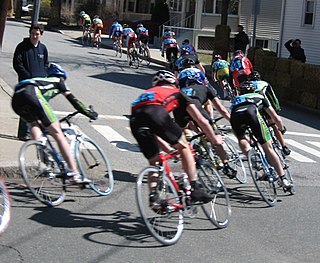
Cycling, also called bicycling or biking, is the use of bicycles for transport, recreation, exercise or sport. People engaged in cycling are referred to as "cyclists", "bicyclists", or "bikers". Apart from two-wheeled bicycles, "cycling" also includes the riding of unicycles, tricycles, quadricycles, recumbent and similar human-powered vehicles (HPVs).

Track cycling is a bicycle racing sport usually held on specially built banked tracks or velodromes using purpose-designed track bicycles.

A velodrome is an arena for track cycling. Modern velodromes feature steeply banked oval tracks, consisting of two 180-degree circular bends connected by two straights. The straights transition to the circular turn through a moderate easement curve.

In sport, racing is a competition of speed, in which competitors try to complete a given task in the shortest amount of time. Typically this involves traversing some distance, but it can be any other task involving speed to reach a specific goal.

Inline speed skating is the roller sport of racing on inline skates. The sport may also be called inline racing by participants. Although it primarily evolved from racing on traditional roller skates, the sport is similar enough to ice speed skating that many competitors are known to switch between inline and ice speed skating according to the season.

Cyclo-cross is a form of bicycle racing. Races typically take place in the autumn and winter, and consist of many laps of a short course featuring pavement, wooded trails, grass, steep hills and obstacles requiring the rider to quickly dismount, carry the bike while navigating the obstruction and remount. Races for senior categories are generally between 40 minutes and an hour long, with the distance varying depending on the ground conditions. The sport is strongest in the traditional road cycling countries such as Belgium, France and the Netherlands.

Cycle sport is competitive physical activity using bicycles. There are several categories of bicycle racing including road bicycle racing, cyclo-cross, mountain bike racing, track cycling, BMX, and cycle speedway. Non-racing cycling sports include artistic cycling, cycle polo, freestyle BMX and mountain bike trials. The Union Cycliste Internationale (UCI) is the world governing body for cycling and international competitive cycling events. The International Human Powered Vehicle Association is the governing body for human-powered vehicles that imposes far fewer restrictions on their design than does the UCI. The UltraMarathon Cycling Association is the governing body for many ultra-distance cycling races.

Oval track racing is a form of closed-circuit motorsport that is contested on an oval-shaped race track. An oval track differs from a road course in that the layout resembles an oval with turns in only one direction, and the direction of traffic is almost universally counter-clockwise. Oval tracks are dedicated motorsport circuits, used predominantly in the United States. They often have banked turns and some, despite the name, are not precisely oval, and the shape of the track can vary.

Road bicycle racing is the cycle sport discipline of road cycling, held primarily on paved roads. Road racing is the most popular professional form of bicycle racing, in terms of numbers of competitors, events and spectators. The two most common competition formats are mass start events, where riders start simultaneously and race to a set finish point; and time trials, where individual riders or teams race a course alone against the clock. Stage races or "tours" take multiple days, and consist of several mass-start or time-trial stages ridden consecutively.

A criterium, or crit, is a bike race consisting of several laps around a closed circuit, the length of each lap or circuit ranging from about 400 m to 10,000 m.

A cyclosportive, or often simply sportive, is a short to long distance, organised, mass-participation cycling event, typically held annually. The Italian term Gran Fondo is commonly used for these events in the United States, Australia and some other English-speaking countries.
Cycling Time Trials is the bicycle racing organisation which supervises individual and team time trials in England and Wales. It was formed out of predecessor body the Road Time Trials Council (RTTC) in 2002.

This is a glossary of terms and jargon used in cycling, mountain biking, and cycle sport.

The Critérium International was a two-day bicycle stage race held in France every spring from 1932 until 2016, typically the last weekend of March. It was formerly known as the Critérium National de la Route, first run in 1932. For many years it was considered a sort of French national championship and was finally opened to non–French cyclists in 1979. Bernard Hinault is the only cyclist to win the race in both its forms. The race has been won by some of the most famous names in cycling, including Jacques Anquetil, Sean Kelly, Bernard Hinault, Miguel Indurain, Stephen Roche, Joop Zoetemelk, Laurent Fignon, Jens Voigt, Cadel Evans and Chris Froome.

Mountain bike racing is the competitive cycle sport discipline of mountain biking held on off-road terrain. The Union Cycliste Internationale (UCI) recognised the discipline relatively late in 1990, when it sanctioned the world championships in Durango, Colorado. The first UCI Mountain Bike World Cup series took place in 1988. Its nine-race circuit covered two continents—Europe and North America—and was sponsored by Grundig. Cross-country racing was the only World Cup sport at this time. In 1993, a six-event downhill World Cup was introduced. In 1996, cross-country mountain biking events were added to the Olympic Games. In 2006, cross-country mountain biking events became part of the World Deaf Cycling Championships for the first time in San Francisco, USA.
Marathon mountain bike races, often referred to as cross-country marathon (XCM), are a very demanding form of mountain bike racing covering at least 40 kilometres usually in mountainous terrain. Events held in Europe are typically just a little longer than the average cross country mountain bike race. Marathon events in the USA and Canada are typically longer than 100 kilometres and are very different from cross country races.

Cross-country (XC) cycling is a discipline of mountain biking. Cross-country cycling became an Olympic sport in [[1996 Summemountain biking practiced at the Olympics.
Audrey McElmury was the first American cyclist to win the Road World Championship. She won in Brno, Czechoslovakia in 1969, having fallen and remounted her bike. Hers was the United States' first world cycling championship since Frank Kramer won the professional sprint race in 1912 and the first ever in road cycling.
The Snake Alley Criterium takes place annually, on Memorial Day weekend, in Burlington, Iowa. The bike race is most famous for riding up Snake Alley, which was named by Ripley's Believe It Or Not as the crookedest alley in the world. The Snake Alley portion of the race includes a 60-foot (18 m) ascent on the 276-foot-long (84 m) alley and includes five major turns.
A Gran Fondo is a type of long-distance road cycling ride originating in Italy in 1970, and roughly translates into English as "Big Ride". Italian Gran Fondos are officially defined and certified by the Italian Cycling Federation as a bicycle event at least 120 kilometres (75 mi) long, and are individually chip-timed races with prizes for the fastest riders in each category. The starts are done en masse, and the format allows for riders of every level to participate, much like a marathon, where most participants are competing against the clock instead of other participants. Traditionally a large meal is served to the participants at the end of the event, and roads are shut down.














